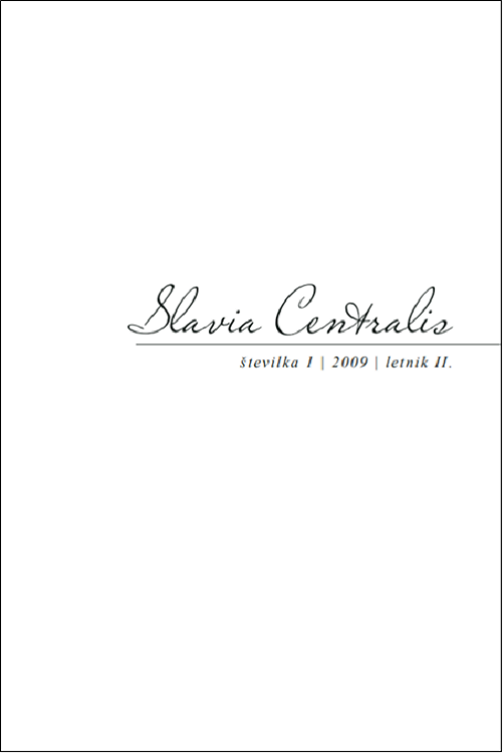Sytuacja językowa w Unii Europejskiej
DOI:
https://doi.org/10.18690/scn.2.1.12–19.2009Ključne besede:
medjezikovni in medkulturni globalizacijski procesi, jezikovna politika, medkulturni dialog, večjezičnost EZ, mali in veliki jeziki EUPovzetek
Vprašanje jezika in kulture v EZ je zelo zapleteno in si ga ni mogoče predstavljati brez upoštevanja rezultatov medjezikovnih in medkulturnih raziskav. Državljane EZ je potrebno soočiti s kulturno in civilizacijsko raznolikostjo, ki jo je potrebno razumeti pravilno in ne kot grožnjo svoji narodni identiteti. Je izobražen prebivalec EZ pripravljen na soočenje z jezikovno, kulturno in civilizacijsko raznolikostjo? Jo znajo državljani EZ ustrezno obravnavati in sprejeti? Kaj so pripravljeni storiti, da bi ohranili in kultivirali svoj lastni jezik, kulturo in identiteto ter jih posredovali naslednji generaciji? To so izzivi, s katerimi se morajo soočiti narodi in suverene države. Nove članice EZ so po dolgi izolaciji bile nenadoma izpostavljene integraciji in globalizaciji.
Prenosi
Literatura
– –, 2001: Magyar nyelvstratégia. Budapest: Magyar Tudományos Akadémia.
Janusz BAŃCZEROWSKI, 1998: Kötelességünk-e gondoskodni anyanyelvünkről. Magyar Nyelv 1, 16–31.
– –, 2000: Nyelvközösségi és nyelvpolitikai kérdések – kihívások és lehetőségek. Magyar Nyelv 4, 391–402.
Detlev BLANKE, 2004: Języki w Unii Europejskiej i Niemcy o równouprawnieniu … własnego języka. The Other (?) Europe. Poznań. 51–73.
Csaba FÖLDES, 2003: Interkulturelle Linguistik. Vorüberlegungen zu Konzepten, Problemen und Desiderata. Universitätsverlag Veszprém: Edition Praesens. 7–61.
Alan FORREST, 1998: The Challenge of Languages in Europe. „Terminologie et Traduction, la revue des services linguistiaues des institutions européenes (Luxemburg)“ 3. 113.
Károly GADÁNYI, János PUSZTAY (ur.), 2002: Közép-Európa: Egység és sokszínűség. Szombathely.
Ferenc GLATZ, 2001: Hét tézis az Európai Unióról és a nyelvekről. Lingua Frankák, regionális lingua frankák, anyanyelvek és a német nyelv. Magyar Tudomány 7, 853–861. http://www.matud.iif.hu/01jul/glatz.html.
László GRÉTSY, 1998: Nyelvhasználat és nemzeti tudat. Magyar Nyelv 1, 31–37.
Jenő KISS, 1997: A magyar nyelvről – nyelvpolitikai megközelítésben. Magyar Tudomány 8, 957–969.
– –, 2001: Hagyomány, nyelv és nyelvközösség. MTA. Közgyűlési előadások I. Budapest: Magyar Tudományos Akadémia. 63–69.
– –, 2006: Tűnődések az Európai Unió nyelvi jövőjéről. Interkulturális kommunikáció: nyelvi és kulturális sokszínűség Európában. Budapest: Eötvös Loránd Tudományegyetem, Bölcsészettudományi Kar, Magyar Tudományos Akadémia, Modern Filológiai Társaság. 84–87.
Ilona KOUTNY, 2004: Komunikacja międzykulturowa w Europie: angielski i esperanto jako alternatywne środki komunikacji. Inna(?) Europa. Poznań: Wydawnictwo-Drukarnia „Prodruk“. 73–96.
István NYOMÁRKAY, 2000: Kis nyelvek az európai csatlakozás küszöbén. Hungarológia 2, 53–62.
– –, 2004: Nyelveink múltja és jelene. Budapest: Opera Slavica Budapestinensia. Linguae Slavicae. Cathedra Philologiae Slavicae.
Bogdan WALCZAK, 2007: Język polski wśród języków świata u progu trzeciego tysiąclecia. Literatura, kultura i język polski w kontekstach i kontaktach światowych. Poznań: Wydawnictwo Naukowe UAM. 89–103.
Prenosi
Objavljeno
Številka
Rubrika
Licenca
Avtorske pravice (c) 2009 Univerzitetna založba Univerze v Mariboru

To delo je licencirano pod Creative Commons Priznanje avtorstva-Nekomercialno 4.0 mednarodno licenco.
Avtorske pravice
Članki so objavljeni pod pogoji mednarodne licence CC BY-SA. https://creativecommons.org/licenses/by-sa/4.0/deed.sl
Plagiatorstvo
Slavia Centralis je nekomercialna in prosto dostopna mednarodna znanstvena revija. Kot taka je zavezana etičnim načelom glede zaupnosti, izvirnosti in intelektualne poštenosti. Kršenje avtorskih pravic in plagiatorstvo obravnava zelo resno, zaradi česar z ustrezno programsko opremo preverja morebitno podobnost z vsebino drugih besedil.
Avtorji morajo upoštevati naslednje:
Predloženo besedilo mora biti izvirni znanstveni članek. Vsi viri morajo biti korektno navedeni. Besedilo ne sme biti istočasno predloženo uredniški presoji drugih publikacij.
Za vključeno gradivo (citati, ilustracije, tabele ipd.) je treba pridobiti ustrezna dovoljenja, ki izhajajo iz avtorskih pravic.
Objava v reviji Slavia Centralis ne predvideva plačila.
